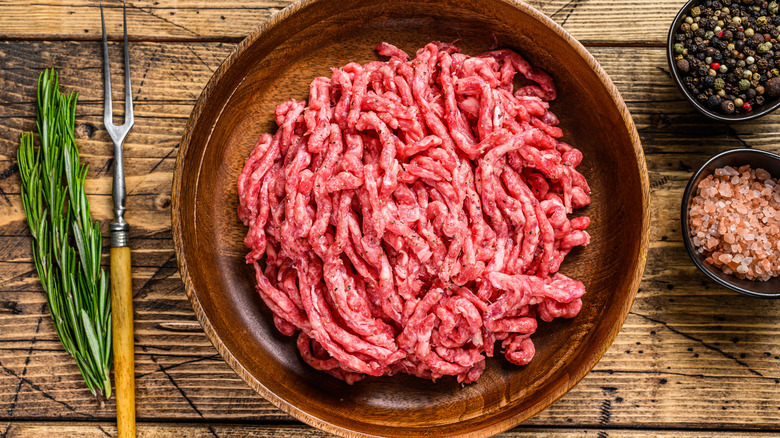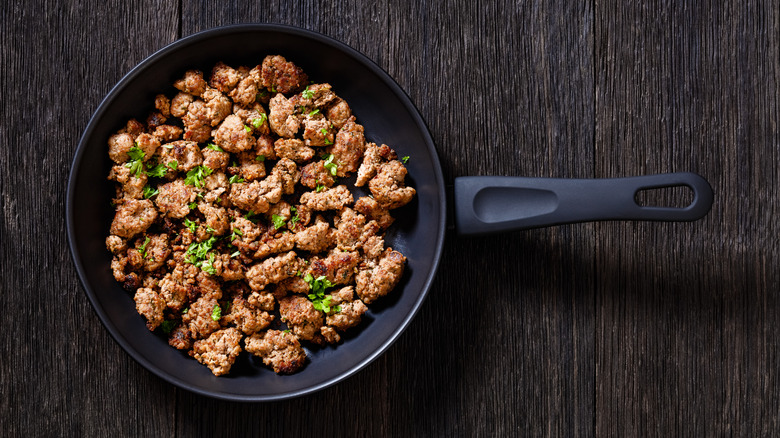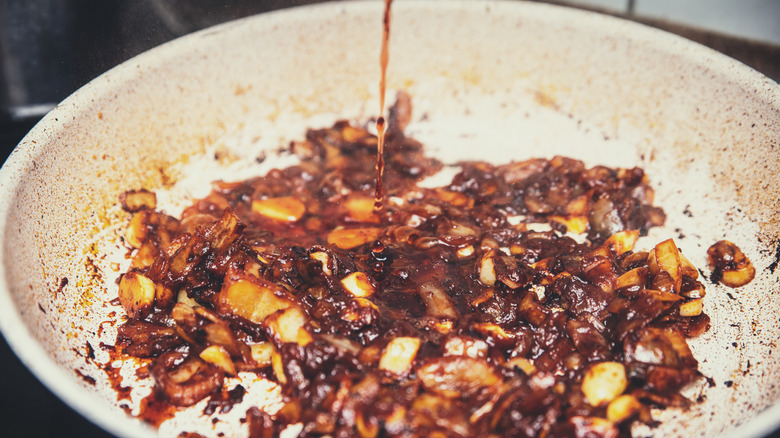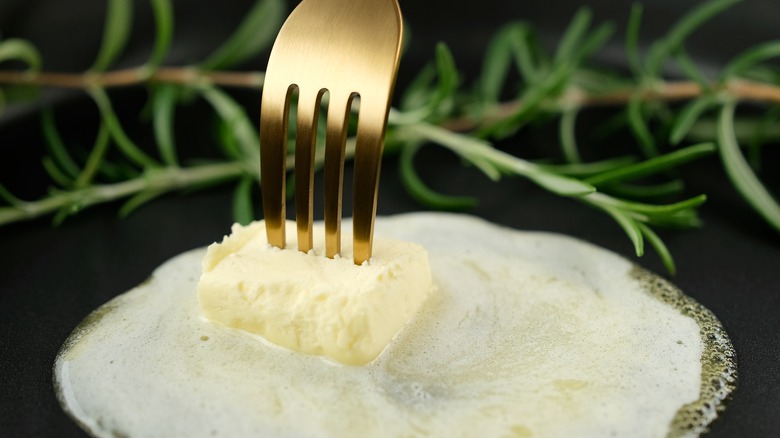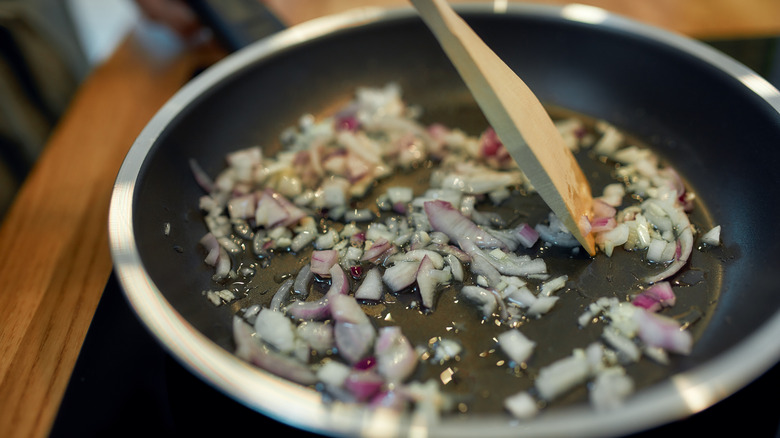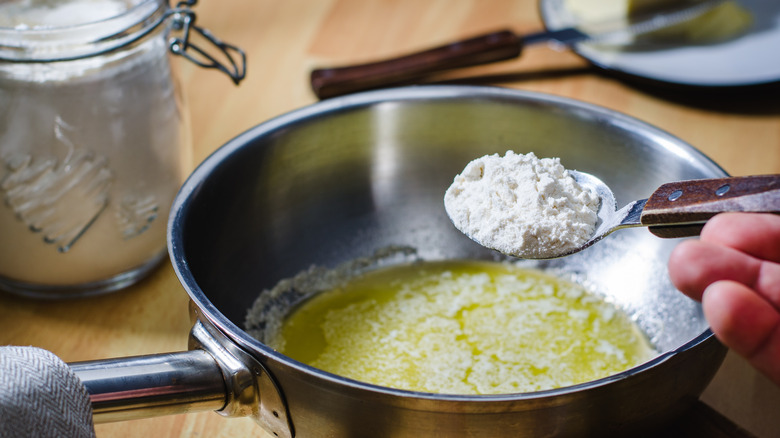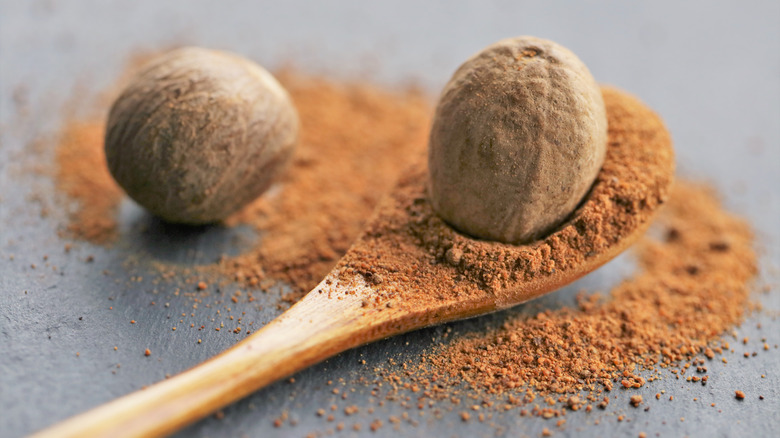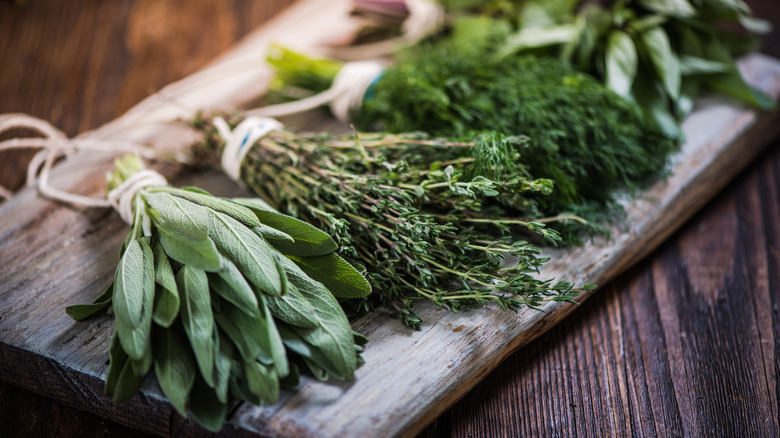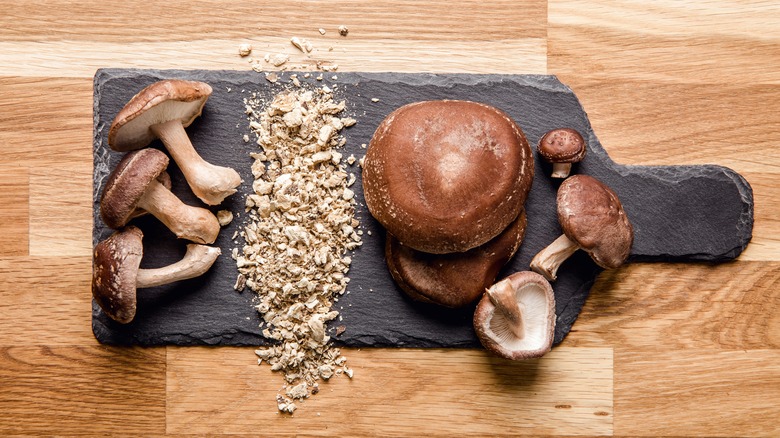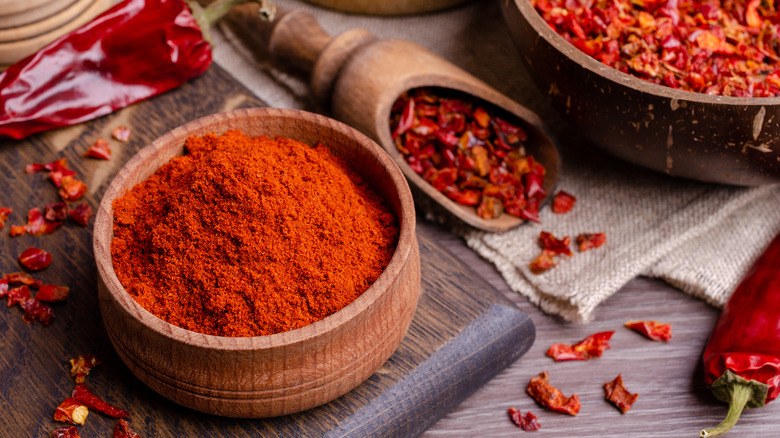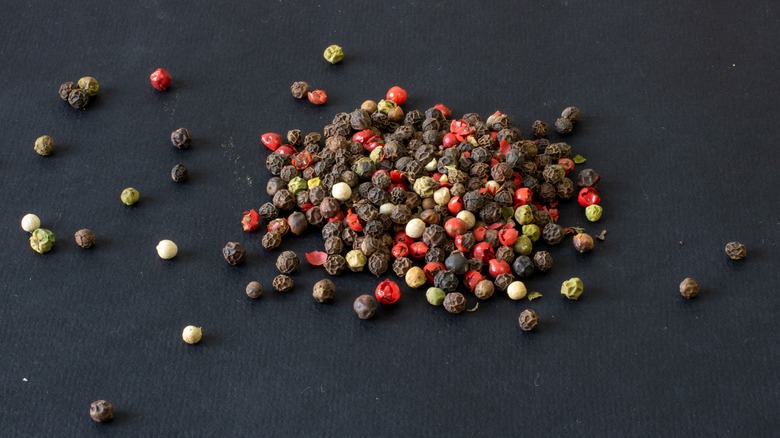14 Ways To Upgrade A Classic Sausage Gravy
Sausage gravy, the classic companion to biscuits, is an American breakfast staple. It originated as a working class recipe created from low cost, available ingredients like pork and flour and fed lumber workers and other laborers across Appalachia and the South, according to The Washington Post. Today, sausage gravy is served everywhere from greasy spoon diners to posh brunch spots, and is enjoyed by folks from all walks of life, ladled over everything from biscuits to hash browns to fried chicken.
The classic sausage gravy recipe is about as no-frills as it gets: sausage, flour, and milk are all you need, along with salt and pepper for seasoning. While simplicity is part of the draw, if you're looking to upgrade your sausage gravy game, there are lots of ways to easily elevate this iconic Southern dish. Use these tips to perfect your technique and boost flavor, and you'll have a better breakfast in the bag.
1. Make your own sausage
While there are plenty of tasty store-bought breakfast sausages on the market, if you want complete control over flavor and quality, making your own sausage is a great way to upgrade your gravy. If you have a meat grinder, you can start with whole cuts to get whatever mix and texture you want. Otherwise, you can skip a step and start with ground meat.
Breakfast sausage is typically made from pork, but since you're making your own, you can customize your meat blend with anything you like -– beef, bison, venison, or even turkey or chicken. Vegetarian meat substitutes are another option, of course, if you're following a plant-based diet.
Once your meat is ground and ready to go, the next step is to add flavorings. Ground herbs and spices like sage, mustard, thyme, and fennel are traditional additions, but you can customize your sausage meat any way you like. Garlic, paprika, and red and black peppers are good options. Brown sugar, honey, or maple syrup balance heat with a touch of sweetness, and can be enhanced with warm spices like cinnamon and ginger. The only limit is your culinary imagination.
2. Cook the sausage first, then remove it
To create classic sausage gravy, you need to start with fat. This will end up mixing with flour to be the thickening base of your sauce, known as roux. You can use any type of fat, but rendering fat from the sausage itself will enhance the meat's flavor in the final gravy. Browning the sausage in the pot or pan you plan on using for the gravy is the easiest process –- once the meat is cooked through, remove it with a slotted utensil, leaving the layer of fat behind.
Setting the sausage aside while you complete the rest of the gravy will keep the meat from overcooking and drying out. What's left in the pan is not just the fat you'll use for your roux, but also browned bits from the meat, known as fond. This substance can be utilized to deepen and intensify your gravy's flavor –- just make sure it isn't burnt, or that unpleasant flavor will taint the whole dish.
3. Add a little alcohol
An easy way to liven up your sausage gravy may be sitting on your home bar. You can enhance and boost its flavors simply by adding a little splash of something boozy, whether it's wine, beer, or a spirit. The best technique is to incorporate alcohol into your gravy towards the beginning of the cooking process, adding it to deglaze the pan after the sausage is cooked. This helps release the flavor from the fond on the bottom of the pan.
Don't add alcohol later in the cooking process, as it can cause the dairy to curdle. You want to add it early and let it reduce, which also allows the alcohol to vaporize and the flavors to concentrate. Some options to consider that will complement the flavors of sausage gravy include sherry, which can add a nutty flavor, or bourbon, which matches the gravy's southern roots. Beer can give the gravy a nice, malty quality. Brandy or Cognac are commonly called for in sauces and can add wonderful complexity to your sausage gravy.
4. Add flavorful fat
If your sausage is made from lean meat, such as turkey, or a vegetarian alternative, it may not give off enough fat to make a roux. In this case, adding more fat to the pan is necessary or your gravy won't thicken enough. Whichever fat you choose will impart its flavor to the final sauce, so keep that in mind when deciding what to use.
Olive or other cooking oils will work fine, but won't add much in the way of flavor or richness. Butter is a great choice -– you can even use brown butter if you want to add a toasty, nutty dimension to your gravy. Other animal fats contribute their own characteristics and can intensify the savory meatiness of the gravy, like duck and bacon fats. Using a combination of different fats in addition to that from the sausage is a great way to add depth, richness, and complexity to your gravy.
5. Add aromatics
Once you've rendered the fat, you can jump straight into making your roux -– but before you reach for the flour, you have a chance to add even more flavor. A few aromatic ingredients thrown into the fat to sweat will infuse your roux — and in turn your gravy — with deeper dimensions of taste.
The classic mirepoix mix of celery, onions, and carrots is a good place to start. This lauded trinity of vegetables is a staple of French cooking and is an easy way to elevate any sauce. There are countless aromatics that can be used, depending on what flavor profile you're shooting for. Shallots, garlic, and chilis will give your gravy a touch of Thai flair, or opt for a Cajun-style gravy with onions, celery, green bell peppers. Don't be afraid to mix and match ingredients, have fun, and experiment.
6. Perfect your roux
Now that you have your flavorful fat and your kitchen is no doubt filled with delectable aromas, it's time to make the roux. This is arguably the most important step in the gravy-making process. Make it incorrectly and your gravy can be lumpy, watery, or stodgy while perfecting your roux means you'll have a rich, silky gravy every time.
A basic roux consists of equal parts fat and flour cooked together until they create a smooth paste. The longer you cook it, the deeper its color will get, and the more intense its flavor will become. A neutral white roux only takes a few minutes to make and will do a fine job thickening your gravy, though it won't impart much in the way of flavor. However, cooking the roux for a bit longer — at least until it's blonde — will add more depth and taste to your gravy and biscuits.
For a classic country sausage gravy, you don't want to go any darker than blond or you'll completely change the gravy's look and flavor. Make sure the flour is completely incorporated into the fat before you move on to the next step to avoid any pockets of dry, uncooked flour in your final gravy.
7. Use fresh, high-quality, full-fat dairy milk
Once your roux is ready, it's time to add the liquid that will make up the bulk of your gravy. Milk is the standard ingredient, although you can upgrade the gravy by using richer dairy products, such as half and half or heavy cream, to create a more decadent sauce. Keep in mind that the better quality of your milk, the better your gravy will taste, so find the freshest and best dairy you can get your hands on.
Whichever liquid or combination of liquids you choose, you'll want to add a little bit at a time and stir it into the roux slowly. This will help the ingredients meld together and create a smoother, sleeker textured sauce. Once all of the liquid is incorporated, keep the gravy simmering until it thickens to the desired consistency.
Of course, if you're making a plant-based gravy you can substitute non-dairy milk alternatives, like almond or soy. Just keep in mind they may not thicken as well as whole milk or cream and may impart their own flavors to the gravy. The same goes for low, reduced, or nonfat dairy milks.
8. Add a pinch of nutmeg
It may seem like an odd and very specific ingredient to add to a sausage gravy, but a little pinch of freshly grated nutmeg adds a surprising boost of flavor. It's an essential addition to classic French mother sauces like bechamel, which is basically what a sausage gravy is: a roux with the addition of milk.
You'll want to grate whole nutmeg to get the most flavor and aroma out of the spice, as opposed to using ground nutmeg from that old shaker that's been on your spice rack for who knows how many years. Grating the nutmeg into the fat at the very start of the cooking process will intensify its flavor even more, toasting it to release stronger aromas and helping its flavor infuse the sauce at every step. You'll be astonished by how much of a difference a tiny sprinkling of nutmeg can make, adding layers of dimension to an otherwise simple sauce and upgrading it into something truly mouthwatering.
9. Simmer with fresh herbs
As your gravy is simmering and thickening, add some pizzazz by throwing some fresh herbs into the liquid. A few green sprigs swimming in the sauce as it cooks can add loads of flavor and aroma, and bright herbal notes are a nice complement to the gravy's indulgent richness.
You can take this opportunity to echo the herbal flavors that are in your sausage — for example, if you added ground sage and thyme to your meat mixture, you could add fresh sage leaves and thyme sprigs to your simmering sauce. Other herbs that work nicely are rosemary, oregano, and bay leaf. Mild, delicate herbs like parsley, basil, and dill don't withstand heat as well as heartier types, so they may be better off sprinkled on top of the finished dish or added at the very end of the cooking process.
Once the flavors have been infused into the gravy, remove the whole herbs by straining the sauce or using a slotted utensil or spider to fish them out. Their flavors and aromas will remain, elevating the gravy's overall taste profile.
10. Boost flavor with umami-loaded ingredients
The concept of umami can be hard to define. Compared to the other four basic tastes -– salty, sweet, sour, and bitter -– umami has a subtlety that's difficult to wrap your head around, as Vox discusses. But without it, much of the food we enjoy just wouldn't taste as good. Its rich, deep, savory character is found in items as disparate as tomatoes and soy sauce.
One thing is for certain, umami-laden ingredients will enhance the flavor of just about anything you cook, including sausage gravy. If you're finding your gravy to be bland or uninspired, it might just need a hit of umami. Stir in some soy sauce or fish sauce, a spoonful of miso, or a dab of tomato paste for a quick boost. Finely-grated parmesan will also do the trick. While it might not be traditional, you can even start your gravy off with some sauteed mushrooms along with the sausage to bulk up both the texture and umami flavor.
11. Spice it up
A great way to make your sausage gravy sing is to give it a pop of heat. A peppy punch of spice works well as a foil to the gravy's creaminess, keeping it from being too bland or unctuous on your palate. Heat can be added in many different ways, depending on whether you want to add just a little piquancy or make it a five-alarm fire.
Starting with the sausage, you can opt for a naturally spicy meat like chorizo, spicy Italian, or linguica. If you're making your own, adding plenty of fresh or dried chili to the sausage mix will up the heat level of your gravy. You can also add fresh or ground chilis to your aromatics, like chopped jalapenos or serranos, chili powder or cayenne pepper, or any type of chili you prefer.
If you've finished your gravy and find it to be lacking in the heat department, you can always stir in a few drops (or spoonfuls, if you can handle it) of your favorite hot sauce. If you're looking for a milder kick, a generous dose of freshly cracked black pepper is a classic addition.
12. Add acidity for balance and zing
If your gravy is tasting a little one-dimensional, another way to upgrade its flavor is to add acid. According to Cook's Country, an acidic ingredient is anything that has a pH level below 7, which is water. Lemon and vinegar are near the most acidic end of the spectrum. If salt and pepper aren't bringing out the flavors of your gravy quite enough, a few dashes of lemon juice or vinegar might just do the trick.
The addition of acidity tones down bitterness in food and adds a little zip and zing of its own, while also enlivening and enhancing flavors. Too much can make foods taste unpleasantly sour, but just the right amount can give your gravy the perfect balance. Besides lemon and vinegar, other acidic ingredients to have up your sleeve include wine, buttermilk, sour cream, and yogurt, while tomato and parmesan both do double-duty as acid and umami bombs.
13. Add some sweetness
Sausage gravy is, by its nature, rich, creamy, and sumptuous, which is why adding heat and acidity work well as balancing elements. But another type of flavor can add a different kind of dimension -– sweetness. When you're shooting for balance, a little bit of sugar can sometimes be the perfect addition to your savory gravy.
If you've made your own sausage, perhaps you've already added an element of sweetness to your dish, as in this maple-sage breakfast sausage recipe. Brown sugar and honey are other ingredients that can be found in breakfast sausages. You can add these items straight into your gravy, too, if you find it lacking dimension. Sweetness can helpfully balance out too much spicy heat, salt, or acidity if you went overboard in any of those categories. When adding sweet ingredients, make sure you use a light hand, or you may end up with a breakfast gravy that tastes more like a dessert.
14. Play around with pepper
A classic sausage gravy is a beautiful sight -– creamy white with coarse chunks of black pepper dotting its glossy surface. Without a liberal dusting of pepper, it's just not the same. It's what gives the gravy its final pop of flavor. You can add pepper throughout the cooking process if you really want to layer its intensity, or simply sprinkle it over the dish at the end -– freshly ground, of course –- to keep the pepper flavor light and fresh.
While basic black pepper is traditional, there's no need to limit yourself -– the world of pepper is vast. Within the black peppercorn family, there are many varieties, each with its own unique qualities, like the complex Telicherry or the intense Brazilian. Green peppercorns are underripe versions of black and have a fresher, brighter flavor. White peppercorns are often added to cream sauces for aesthetic reasons but have a unique flavor too. Mix all three together to create a particularly potent and delicious peppercorn melange that is sure to upgrade your basic sausage gravy.
Other types of peppers to experiment with include long pepper and Cubeb pepper, each with its own pungent character, and Sichuan pepper, famous for its mouth-numbing property. Mix and match these styles to create a unique, spicy flavor profile, and you'll have a truly upgraded sausage gravy.

